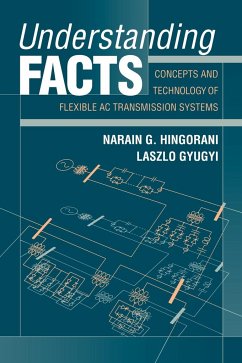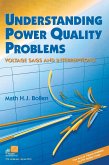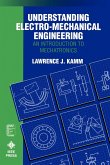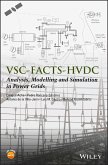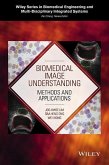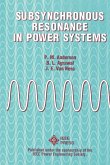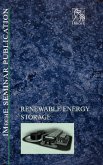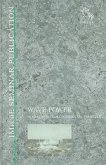Narain G Hingorani, Laszlo Gyugyi
Understanding Facts
Concepts and Technology of Flexible AC Transmission Systems
Narain G Hingorani, Laszlo Gyugyi
Understanding Facts
Concepts and Technology of Flexible AC Transmission Systems
- Gebundenes Buch
- Merkliste
- Auf die Merkliste
- Bewerten Bewerten
- Teilen
- Produkt teilen
- Produkterinnerung
- Produkterinnerung
Electrical Engineering Understanding FACTS Concepts and Technology of Flexible AC Transmission Systems The Flexible AC Transmission System (FACTS)--a new technology based on power electronics--offers an opportunity to enhance controllability, stability, and power transfer capability of ac transmission systems. Pioneers in FACTS and leading world experts in power electronics applications, Narain G. Hingorani and Laszlo Gyugyi, have teamed together to bring you the definitive book on FACTS technology. Drs. Hingorani and Gyugyi present a practical approach to FACTS that will enable electrical…mehr
Andere Kunden interessierten sich auch für
![Understanding Power Quality Problems Understanding Power Quality Problems]() Math H J BollenUnderstanding Power Quality Problems225,99 €
Math H J BollenUnderstanding Power Quality Problems225,99 €![Understanding Electro-Mechanical Engineering Understanding Electro-Mechanical Engineering]() Lawrence J KammUnderstanding Electro-Mechanical Engineering137,99 €
Lawrence J KammUnderstanding Electro-Mechanical Engineering137,99 €![Vsc-Facts-Hvdc Vsc-Facts-Hvdc]() Enrique E. AchaVsc-Facts-Hvdc149,99 €
Enrique E. AchaVsc-Facts-Hvdc149,99 €![Biomedical Image Understanding Biomedical Image Understanding]() Joo-Hwee LimBiomedical Image Understanding183,99 €
Joo-Hwee LimBiomedical Image Understanding183,99 €![Subsynchronous Resonance in Power Systems Subsynchronous Resonance in Power Systems]() Paul M AndersonSubsynchronous Resonance in Power Systems180,99 €
Paul M AndersonSubsynchronous Resonance in Power Systems180,99 €![Renewable Energy Storage Renewable Energy Storage]() Pep (Professional Engineering Publishers)Renewable Energy Storage147,99 €
Pep (Professional Engineering Publishers)Renewable Energy Storage147,99 €![Wave Power Wave Power]() Pep (Professional Engineering Publishers)Wave Power215,99 €
Pep (Professional Engineering Publishers)Wave Power215,99 €-
-
-
Electrical Engineering Understanding FACTS Concepts and Technology of Flexible AC Transmission Systems The Flexible AC Transmission System (FACTS)--a new technology based on power electronics--offers an opportunity to enhance controllability, stability, and power transfer capability of ac transmission systems. Pioneers in FACTS and leading world experts in power electronics applications, Narain G. Hingorani and Laszlo Gyugyi, have teamed together to bring you the definitive book on FACTS technology. Drs. Hingorani and Gyugyi present a practical approach to FACTS that will enable electrical engineers working in the power industry to understand the principles underlying this advanced system. Understanding FACTS will enhance your expertise in equipment specifications and engineering design, and will offer you an informed view of the future of power electronics in ac transmission systems. This comprehensive reference book provides in-depth discussions on: * Power semiconductor devices * Voltage-sourced and current-sourced converters * Specific FACTS Controllers, including SVC, STATCOM, TCSC, SSSC, UPFC, IPFC plus voltage regulators, phase shifters, and special Controllers with a detailed comparison of their performance attributes * Major FACTS applications in the U.S. Understanding FACTS is an authoritative resource that is essential reading for electrical engineers who want to stay on the cusp of the power electronics revolution.
Hinweis: Dieser Artikel kann nur an eine deutsche Lieferadresse ausgeliefert werden.
Hinweis: Dieser Artikel kann nur an eine deutsche Lieferadresse ausgeliefert werden.
Produktdetails
- Produktdetails
- Verlag: Wiley
- Seitenzahl: 464
- Erscheinungstermin: 24. Dezember 1999
- Englisch
- Abmessung: 260mm x 183mm x 29mm
- Gewicht: 1045g
- ISBN-13: 9780780334557
- ISBN-10: 0780334558
- Artikelnr.: 22309841
- Herstellerkennzeichnung
- Libri GmbH
- Europaallee 1
- 36244 Bad Hersfeld
- gpsr@libri.de
- Verlag: Wiley
- Seitenzahl: 464
- Erscheinungstermin: 24. Dezember 1999
- Englisch
- Abmessung: 260mm x 183mm x 29mm
- Gewicht: 1045g
- ISBN-13: 9780780334557
- ISBN-10: 0780334558
- Artikelnr.: 22309841
- Herstellerkennzeichnung
- Libri GmbH
- Europaallee 1
- 36244 Bad Hersfeld
- gpsr@libri.de
About the Authors... Narain G. Hingorani is credited with originating the concepts ofFACTS and Custom Power. He is a retired vice president ofElectrical Systems at EPRI and provides consulting services thathelp utilities plan and purchase power electronics technology. Dr.Hingorani has published widely on HVDC and ac transmission and iscoauthor of High Voltage Direct Current Power Transmission (GarawayLtd., 1960). Dr. Hingorani is the recipient of the 1985 Uno LammMedal of the IEEE Power Engineering Society for outstandingcontributions to High Voltage Direct Current Technology and the1995 IEEE Lamme Medal for leadership and pioneering contributionsto the transmission and distribution of electric power. He is aFellow of the IEEE and in 1988 he was elected to the NationalAcademy of Engineering. Laszlo Gyugyi is technical director at Siemens FACTS & PowerQuality Division in Orlando, Florida. His research covers a broadrange of power electronic circuits and systems. In collaborationwith B. R. Pelly, Dr. Gyugyi established the theoreticalfoundations of ac to ac switching converters in Static PowerFrequency Changers (John Wiley & Sons, 1976). Subsequently, hehas focused on the development of new power electronic technologiesfor electric transmission and distribution systems, and haspioneered the converter-based approach for FACTS. Dr. Gyugyi haspublished more than 50 papers in the field and holds 76 U.S.patents. He is the recipient of the 1992 Westinghouse Order ofMerit, the 1994 William E. Newell Power Electronics Award of theIEEE Power Electronics Society, and the first Flexible ACTransmission System (FACTS) Award given by the IEEE PowerEngineering Society in 1999. He is a Fellow of the IEE.
PREFACE xiii
ACKNOWLEDGMENTS xvii
CHAPTER 1 FACTS Concept and General System Considerations 1
1.1 Transmission Interconnections 1
1.1.1 Why We Need Transmission Interconnections 1
1.1.2 Opportunities for FACTS 2
1.2 Flow of Power in an AC System 3
1.2.1 Power Flow in Parallel Paths 4
1.2.2 Power Flow in Meshed System 4
1.3 What Limits the Loading Capability? 7
1.4 Power Flow and Dynamic Stability Considerations of a Transmission
Interconnection 9
1.5 Relative Importance of Controllable Parameters 12
1.6 Basic Types of FACTS Controllers 13
1.6.1 Relative Importance of Different Types of Controllers 14
1.7 Brief Description and Definitions of FACTS Controllers 16
1.7.1 Shunt Connected Controllers 18
1.7.2 Series Connected Controllers 20
1.7.3 Combined Shunt and Series Connected Controllers 23
1.7.4 Other Controllers 24
1.8 Checklist of Possible Benefits from FACTS Technology 25
1.9 In Perspective: HVDC or FACTS 26
CHAPTER 2 Power Semiconductor Devices 37
2.1 Perspective on Power Devices 37
2.1.1 Types of High-Power Devices 40
2.2 Principal High-Power Device Characteristics and Requirements 41
2.2.1 Voltage and Current Ratings 41
2.2.2 Losses and Speed of Switching 42
2.2.3 Parameter Trade-Off of Devices 44
2.3 Power Device Material 45
2.4 Diode (Pn Junction) 46
2.5 Transistor 48
2.5.1 MOSFET 51
2.6 Thyristor (without Turn-Off Capability) 52
2.7 Gate Turn-Off Thyristor (GTO) 54
2.7.1 Turn-On and Turn-Off Process 56
2.8 MOS Turn-Off Thyristor (MTO) 58
2.9 Emitter Turn-Off Thyristor 60
2.10 Integrated Gate-Commutated Thyristor (GCT and IGCT) 61
2.11 Insulated Gate Bipolar Transistor (IGBT) 63
2.12 MOS-Controlled Thyristor (MCT) 64
CHAPTER 3 Voltage-Sourced Converters 67
3.1 Basic Concept of Voltage-Sourced Converters 67
3.2 Single-Phase Full-Wave Bridge Converter Operation 69
3.3 Single Phase-Leg Operation 72
3.4 Square-Wave Voltage Harmonics for a Single-Phase Bridge 73
3.5 Three-Phase Full-Wave Bridge Converter 74
3.5.1 Converter Operation 74
3.5.2 Fundamental and Harmonics for a Three-Phase Bridge Converter 77
3.6 Sequence of Valve Conduction Process in Each Phase-Leg 80
3.7 Transformer Connections for 12-Pulse Operation 83
3.8 24- and 48-Pulse Operation 85
3.9 Three-Level Voltage-Sourced Converter 87
3.9.1 Operation of Three-Level Converter 87
3.9.2 Fundamental and Harmonic Voltages for a Three-Level Converter 88
3.9.3 Three-Level Converter with Parallel Legs 91
3.10 Pulse-Width Modulation (PWM) Converter 91
3.11 Generalized Technique of Harmonic Elimination and Voltage Control 95
3.12 Converter Rating-General Comments 97
CHAPTER 4 Self- and Line-Commutated Current-Sourced Converters 103
4.1 Basic Concept of Current-Sourced Converters 103
4.2 Three-Phase Full-Wave Diode Rectifier 106
4.3 Thyristor-Based Converter (With Gate Turn-On but Without Gate Turn-Off)
110
4.3.1 Rectifier Operation 110
4.3.2 Inverter Operation 113
4.3.3 Valve Voltage 116
4.3.4 Commutation Failures 118
4.3.5 AC Current Harmonics 120
4.3.6 DC Voltage Harmonics 126
4.4 Current-Sourced Converter with Turn-Off Devices (Current Stiff
Converter) 129
4.5 Current-Sourced Versus Voltage-Sourced Converters 132
CHAPTER 5 Static Shunt Compensators: SVC and STATCOM 135
5.1 Objectives of Shunt Compensation 135
5.1.1 Midpoint Voltage Regulation for Line Segmentation 135
5.1.2 End of Line Voltage Support to Prevent Voltage Instability 138
5.1.3 Improvement of Transient Stability 138
5.1.4 Power Oscillation Damping 142
5.1.5 Summary of Compensator Requirements 143
5.2 Methods of Controllable Var Generation 144
5.2.1 Variable Impedance Type Static Var Generators 145
5.2.2 Switching Converter Type Var Generators 164
5.2.3 Hybrid Var Generators: Switching Converter with TSC and TCR 177
5.2.4 Summary of Static Var Generators 178
5.3 Static Var Compensators: SVC and STATCOM 179
5.3.1 The Regulation Slope 183
5.3.2 Transfer Function and Dynamic Performance 184
5.3.3 Transient Stability Enhancement and Power Oscillation Damping 188
5.3.4 Var Reserve (Operating Point) Control 193
5.3.5 Summary of Compensator Control 195
5.4 Comparison Between STATCOM and SVC 197
5.4.1 V-I and V-Q Characteristics 197
5.4.2 Transient Stability 199
5.4.3 Response Time 201
5.4.4 Capability to Exchange Real Power 201
5.4.5 Operation With Unbalanced AC System 202
5.4.6 Loss Versus Var Output Characteristic 204
5.4.7 Physical Size and Installation 204
5.4.8 Merits of Hybrid Compensator 205
5.5 Static Var Systems 205
CHAPTER 6 Static Series Compensators: GCSC, TSSC, TCSC, and SSSC 209
6.1 Objectives of Series Compensation 209
6.1.1 Concept of Series Capacitive Compensation 210
6.1.2 Voltage Stability 211
6.1.3 Improvement of Transient Stability 212
6.1.4 Power Oscillation Damping 213
6.1.5 Subsynchronous Oscillation Damping 214
6.1.6 Summary of Functional Requirements 215
6.1.7 Approaches to Controlled Series Compensation 216
6.2 Variable Impedance Type Series Compensators 216
6.2.1 GTO Thyristor-Controlled Series Capacitor (GCSC) 216
6.2.2 Thyristor-Switched Series Capacitor (TSSC) 223
6.2.3 Thyristor-Controlled Series Capacitor (TCSC) 225
6.2.4 Subsynchronous Characteristics 236
6.2.5 Basic Operating Control Schemes for GCSC, TSSC, and TCSC 239
6.3 Switching Converter Type Series Compensators 243
6.3.1 The Static Synchronous Series Compensator (SSSC) 244
6.3.2 Transmitted Power Versus Transmission Angle Characteristic 245
6.3.3 Control Range and VA Rating 248
6.3.4 Capability to Provide Real Power Compensation 250
6.3.5 Immunity to Subsynchronous Resonance 254
6.3.6 Internal Control 257
6.4 External (System) Control for Series Reactive Compensators 259
6.5 Summary of Characteristics and Features 261
CHAPTER 7 Static Voltage and Phase Angle Regulators: TCVR and TCPAR 267
7.1 Objectives of Voltage and Phase Angle Regulators 267
7.1.1 Voltage and Phase Angle Regulation 269
7.1.2 Power Flow Control by Phase Angle Regulators 270
7.1.3 Real and Reactive Loop Power Flow Control 272
7.1.4 Improvement of Transient Stability with Phase Angle Regulators 274
7.1.5 Power Oscillation Damping with Phase Angle Regulators 276
7.1.6 Summary of Functional Requirements 277
7.2 Approaches to Thyristor-Controlled Voltage and Phase Angle Regulators
(TCVRs and TCPARs) 277
7.2.1 Continuously Controllable Thyristor Tap Changers 280
7.2.2 Thyristor Tap Changer with Discrete Level Control 286
7.2.3 Thyristor Tap Changer Valve Rating Considerations 289
7.3 Switching Converter-Based Voltage and Phase Angle Regulators 290
7.4 Hybrid Phase Angle Regulators 293
CHAPTER 8 Combined Compensators: Unified Power Flow Controller (UPFC) and
Interline Power Flow Controller (IPFC) 297
8.1 Introduction 297
8.2 The Unified Power Flow Controller 299
8.2.1 Basic Operating Principles 300
8.2.2 Conventional Transmission Control Capabilities 301
8.2.3 Independent Real and Reactive Power Flow Control 305
8.2.4 Comparison of UPFC to Series Compensators and Phase Angle Regulators
308
8.2.5 Control Structure 315
8.2.6 Basic Control System for P and Q Control 319
8.2.7 Dynamic Performance 322
8.2.8 Hybrid Arrangements: UPFC with a Phase Shifting Transformer 329
8.3 The Interline Power Flow Controller (IPFC) 333
8.3.1 Basic Operating Principles and Characteristics 334
8.3.2 Control Structure 343
8.3.3 Computer Simulation 344
8.3.4 Practical and Application Considerations 346
8.4 Generalized and Multifunctional FACTS Controllers 348
CHAPTER 9 Special Purpose Facts Controllers: NGH-SSR Damping Scheme and
Thyristor-Controlled Braking Resistor 353
9.1 Subsynchronous Resonance 353
9.2 NGH-SSR Damping Scheme 358
9.2.1 Basic Concept 358
9.2.2. Design and Operation Aspects 361
9.3 Thyristor-Controlled Braking Resistor (TCBR) 362
9.3.1 Basic Concept 362
9.3.2 Design and Operation Aspects 364
CHAPTER 10 Application Examples 373
10.1 WAPA's Kayenta Advanced Series Capacitor (ASC) 373
10.1.1 Introduction and Planning Aspects 373
10.1.2 Functional Specification 376
10.1.3 Design and Operational Aspects 377
10.1.4 Results of the Project 380
10.2 BPA's Slatt Thyristor-Controlled Series Capacitor (TCSC) 382
10.2.1 Introduction and Planning Aspects 382
10.2.2 Functional Specifications 384
10.2.3 Design and Operational Aspects 387
10.2.4 Results of the Project 392
10.3 TVA's Sullivan Static Synchronous Compensator (STATCOM) 394
10.3.1 Introduction and Planning Aspects 394
10.3.2 STATCOM Design Summary 396
10.3.3 Steady-State Performance 400
10.3.4 Dynamic Performance 401
10.3.5 Results of the Project 407
10.4 AEP's Inez Unified Power Flow Controller (UPFC) 407
10.4.1 Introduction and Planning Aspects 407
10.4.2 Description of the UPFC 411
10.4.3 Operating Performance 414
10.4.4 Results of the Project 423
INDEX 425
ABOUT THE AUTHORS 431
ACKNOWLEDGMENTS xvii
CHAPTER 1 FACTS Concept and General System Considerations 1
1.1 Transmission Interconnections 1
1.1.1 Why We Need Transmission Interconnections 1
1.1.2 Opportunities for FACTS 2
1.2 Flow of Power in an AC System 3
1.2.1 Power Flow in Parallel Paths 4
1.2.2 Power Flow in Meshed System 4
1.3 What Limits the Loading Capability? 7
1.4 Power Flow and Dynamic Stability Considerations of a Transmission
Interconnection 9
1.5 Relative Importance of Controllable Parameters 12
1.6 Basic Types of FACTS Controllers 13
1.6.1 Relative Importance of Different Types of Controllers 14
1.7 Brief Description and Definitions of FACTS Controllers 16
1.7.1 Shunt Connected Controllers 18
1.7.2 Series Connected Controllers 20
1.7.3 Combined Shunt and Series Connected Controllers 23
1.7.4 Other Controllers 24
1.8 Checklist of Possible Benefits from FACTS Technology 25
1.9 In Perspective: HVDC or FACTS 26
CHAPTER 2 Power Semiconductor Devices 37
2.1 Perspective on Power Devices 37
2.1.1 Types of High-Power Devices 40
2.2 Principal High-Power Device Characteristics and Requirements 41
2.2.1 Voltage and Current Ratings 41
2.2.2 Losses and Speed of Switching 42
2.2.3 Parameter Trade-Off of Devices 44
2.3 Power Device Material 45
2.4 Diode (Pn Junction) 46
2.5 Transistor 48
2.5.1 MOSFET 51
2.6 Thyristor (without Turn-Off Capability) 52
2.7 Gate Turn-Off Thyristor (GTO) 54
2.7.1 Turn-On and Turn-Off Process 56
2.8 MOS Turn-Off Thyristor (MTO) 58
2.9 Emitter Turn-Off Thyristor 60
2.10 Integrated Gate-Commutated Thyristor (GCT and IGCT) 61
2.11 Insulated Gate Bipolar Transistor (IGBT) 63
2.12 MOS-Controlled Thyristor (MCT) 64
CHAPTER 3 Voltage-Sourced Converters 67
3.1 Basic Concept of Voltage-Sourced Converters 67
3.2 Single-Phase Full-Wave Bridge Converter Operation 69
3.3 Single Phase-Leg Operation 72
3.4 Square-Wave Voltage Harmonics for a Single-Phase Bridge 73
3.5 Three-Phase Full-Wave Bridge Converter 74
3.5.1 Converter Operation 74
3.5.2 Fundamental and Harmonics for a Three-Phase Bridge Converter 77
3.6 Sequence of Valve Conduction Process in Each Phase-Leg 80
3.7 Transformer Connections for 12-Pulse Operation 83
3.8 24- and 48-Pulse Operation 85
3.9 Three-Level Voltage-Sourced Converter 87
3.9.1 Operation of Three-Level Converter 87
3.9.2 Fundamental and Harmonic Voltages for a Three-Level Converter 88
3.9.3 Three-Level Converter with Parallel Legs 91
3.10 Pulse-Width Modulation (PWM) Converter 91
3.11 Generalized Technique of Harmonic Elimination and Voltage Control 95
3.12 Converter Rating-General Comments 97
CHAPTER 4 Self- and Line-Commutated Current-Sourced Converters 103
4.1 Basic Concept of Current-Sourced Converters 103
4.2 Three-Phase Full-Wave Diode Rectifier 106
4.3 Thyristor-Based Converter (With Gate Turn-On but Without Gate Turn-Off)
110
4.3.1 Rectifier Operation 110
4.3.2 Inverter Operation 113
4.3.3 Valve Voltage 116
4.3.4 Commutation Failures 118
4.3.5 AC Current Harmonics 120
4.3.6 DC Voltage Harmonics 126
4.4 Current-Sourced Converter with Turn-Off Devices (Current Stiff
Converter) 129
4.5 Current-Sourced Versus Voltage-Sourced Converters 132
CHAPTER 5 Static Shunt Compensators: SVC and STATCOM 135
5.1 Objectives of Shunt Compensation 135
5.1.1 Midpoint Voltage Regulation for Line Segmentation 135
5.1.2 End of Line Voltage Support to Prevent Voltage Instability 138
5.1.3 Improvement of Transient Stability 138
5.1.4 Power Oscillation Damping 142
5.1.5 Summary of Compensator Requirements 143
5.2 Methods of Controllable Var Generation 144
5.2.1 Variable Impedance Type Static Var Generators 145
5.2.2 Switching Converter Type Var Generators 164
5.2.3 Hybrid Var Generators: Switching Converter with TSC and TCR 177
5.2.4 Summary of Static Var Generators 178
5.3 Static Var Compensators: SVC and STATCOM 179
5.3.1 The Regulation Slope 183
5.3.2 Transfer Function and Dynamic Performance 184
5.3.3 Transient Stability Enhancement and Power Oscillation Damping 188
5.3.4 Var Reserve (Operating Point) Control 193
5.3.5 Summary of Compensator Control 195
5.4 Comparison Between STATCOM and SVC 197
5.4.1 V-I and V-Q Characteristics 197
5.4.2 Transient Stability 199
5.4.3 Response Time 201
5.4.4 Capability to Exchange Real Power 201
5.4.5 Operation With Unbalanced AC System 202
5.4.6 Loss Versus Var Output Characteristic 204
5.4.7 Physical Size and Installation 204
5.4.8 Merits of Hybrid Compensator 205
5.5 Static Var Systems 205
CHAPTER 6 Static Series Compensators: GCSC, TSSC, TCSC, and SSSC 209
6.1 Objectives of Series Compensation 209
6.1.1 Concept of Series Capacitive Compensation 210
6.1.2 Voltage Stability 211
6.1.3 Improvement of Transient Stability 212
6.1.4 Power Oscillation Damping 213
6.1.5 Subsynchronous Oscillation Damping 214
6.1.6 Summary of Functional Requirements 215
6.1.7 Approaches to Controlled Series Compensation 216
6.2 Variable Impedance Type Series Compensators 216
6.2.1 GTO Thyristor-Controlled Series Capacitor (GCSC) 216
6.2.2 Thyristor-Switched Series Capacitor (TSSC) 223
6.2.3 Thyristor-Controlled Series Capacitor (TCSC) 225
6.2.4 Subsynchronous Characteristics 236
6.2.5 Basic Operating Control Schemes for GCSC, TSSC, and TCSC 239
6.3 Switching Converter Type Series Compensators 243
6.3.1 The Static Synchronous Series Compensator (SSSC) 244
6.3.2 Transmitted Power Versus Transmission Angle Characteristic 245
6.3.3 Control Range and VA Rating 248
6.3.4 Capability to Provide Real Power Compensation 250
6.3.5 Immunity to Subsynchronous Resonance 254
6.3.6 Internal Control 257
6.4 External (System) Control for Series Reactive Compensators 259
6.5 Summary of Characteristics and Features 261
CHAPTER 7 Static Voltage and Phase Angle Regulators: TCVR and TCPAR 267
7.1 Objectives of Voltage and Phase Angle Regulators 267
7.1.1 Voltage and Phase Angle Regulation 269
7.1.2 Power Flow Control by Phase Angle Regulators 270
7.1.3 Real and Reactive Loop Power Flow Control 272
7.1.4 Improvement of Transient Stability with Phase Angle Regulators 274
7.1.5 Power Oscillation Damping with Phase Angle Regulators 276
7.1.6 Summary of Functional Requirements 277
7.2 Approaches to Thyristor-Controlled Voltage and Phase Angle Regulators
(TCVRs and TCPARs) 277
7.2.1 Continuously Controllable Thyristor Tap Changers 280
7.2.2 Thyristor Tap Changer with Discrete Level Control 286
7.2.3 Thyristor Tap Changer Valve Rating Considerations 289
7.3 Switching Converter-Based Voltage and Phase Angle Regulators 290
7.4 Hybrid Phase Angle Regulators 293
CHAPTER 8 Combined Compensators: Unified Power Flow Controller (UPFC) and
Interline Power Flow Controller (IPFC) 297
8.1 Introduction 297
8.2 The Unified Power Flow Controller 299
8.2.1 Basic Operating Principles 300
8.2.2 Conventional Transmission Control Capabilities 301
8.2.3 Independent Real and Reactive Power Flow Control 305
8.2.4 Comparison of UPFC to Series Compensators and Phase Angle Regulators
308
8.2.5 Control Structure 315
8.2.6 Basic Control System for P and Q Control 319
8.2.7 Dynamic Performance 322
8.2.8 Hybrid Arrangements: UPFC with a Phase Shifting Transformer 329
8.3 The Interline Power Flow Controller (IPFC) 333
8.3.1 Basic Operating Principles and Characteristics 334
8.3.2 Control Structure 343
8.3.3 Computer Simulation 344
8.3.4 Practical and Application Considerations 346
8.4 Generalized and Multifunctional FACTS Controllers 348
CHAPTER 9 Special Purpose Facts Controllers: NGH-SSR Damping Scheme and
Thyristor-Controlled Braking Resistor 353
9.1 Subsynchronous Resonance 353
9.2 NGH-SSR Damping Scheme 358
9.2.1 Basic Concept 358
9.2.2. Design and Operation Aspects 361
9.3 Thyristor-Controlled Braking Resistor (TCBR) 362
9.3.1 Basic Concept 362
9.3.2 Design and Operation Aspects 364
CHAPTER 10 Application Examples 373
10.1 WAPA's Kayenta Advanced Series Capacitor (ASC) 373
10.1.1 Introduction and Planning Aspects 373
10.1.2 Functional Specification 376
10.1.3 Design and Operational Aspects 377
10.1.4 Results of the Project 380
10.2 BPA's Slatt Thyristor-Controlled Series Capacitor (TCSC) 382
10.2.1 Introduction and Planning Aspects 382
10.2.2 Functional Specifications 384
10.2.3 Design and Operational Aspects 387
10.2.4 Results of the Project 392
10.3 TVA's Sullivan Static Synchronous Compensator (STATCOM) 394
10.3.1 Introduction and Planning Aspects 394
10.3.2 STATCOM Design Summary 396
10.3.3 Steady-State Performance 400
10.3.4 Dynamic Performance 401
10.3.5 Results of the Project 407
10.4 AEP's Inez Unified Power Flow Controller (UPFC) 407
10.4.1 Introduction and Planning Aspects 407
10.4.2 Description of the UPFC 411
10.4.3 Operating Performance 414
10.4.4 Results of the Project 423
INDEX 425
ABOUT THE AUTHORS 431
PREFACE xiii
ACKNOWLEDGMENTS xvii
CHAPTER 1 FACTS Concept and General System Considerations 1
1.1 Transmission Interconnections 1
1.1.1 Why We Need Transmission Interconnections 1
1.1.2 Opportunities for FACTS 2
1.2 Flow of Power in an AC System 3
1.2.1 Power Flow in Parallel Paths 4
1.2.2 Power Flow in Meshed System 4
1.3 What Limits the Loading Capability? 7
1.4 Power Flow and Dynamic Stability Considerations of a Transmission
Interconnection 9
1.5 Relative Importance of Controllable Parameters 12
1.6 Basic Types of FACTS Controllers 13
1.6.1 Relative Importance of Different Types of Controllers 14
1.7 Brief Description and Definitions of FACTS Controllers 16
1.7.1 Shunt Connected Controllers 18
1.7.2 Series Connected Controllers 20
1.7.3 Combined Shunt and Series Connected Controllers 23
1.7.4 Other Controllers 24
1.8 Checklist of Possible Benefits from FACTS Technology 25
1.9 In Perspective: HVDC or FACTS 26
CHAPTER 2 Power Semiconductor Devices 37
2.1 Perspective on Power Devices 37
2.1.1 Types of High-Power Devices 40
2.2 Principal High-Power Device Characteristics and Requirements 41
2.2.1 Voltage and Current Ratings 41
2.2.2 Losses and Speed of Switching 42
2.2.3 Parameter Trade-Off of Devices 44
2.3 Power Device Material 45
2.4 Diode (Pn Junction) 46
2.5 Transistor 48
2.5.1 MOSFET 51
2.6 Thyristor (without Turn-Off Capability) 52
2.7 Gate Turn-Off Thyristor (GTO) 54
2.7.1 Turn-On and Turn-Off Process 56
2.8 MOS Turn-Off Thyristor (MTO) 58
2.9 Emitter Turn-Off Thyristor 60
2.10 Integrated Gate-Commutated Thyristor (GCT and IGCT) 61
2.11 Insulated Gate Bipolar Transistor (IGBT) 63
2.12 MOS-Controlled Thyristor (MCT) 64
CHAPTER 3 Voltage-Sourced Converters 67
3.1 Basic Concept of Voltage-Sourced Converters 67
3.2 Single-Phase Full-Wave Bridge Converter Operation 69
3.3 Single Phase-Leg Operation 72
3.4 Square-Wave Voltage Harmonics for a Single-Phase Bridge 73
3.5 Three-Phase Full-Wave Bridge Converter 74
3.5.1 Converter Operation 74
3.5.2 Fundamental and Harmonics for a Three-Phase Bridge Converter 77
3.6 Sequence of Valve Conduction Process in Each Phase-Leg 80
3.7 Transformer Connections for 12-Pulse Operation 83
3.8 24- and 48-Pulse Operation 85
3.9 Three-Level Voltage-Sourced Converter 87
3.9.1 Operation of Three-Level Converter 87
3.9.2 Fundamental and Harmonic Voltages for a Three-Level Converter 88
3.9.3 Three-Level Converter with Parallel Legs 91
3.10 Pulse-Width Modulation (PWM) Converter 91
3.11 Generalized Technique of Harmonic Elimination and Voltage Control 95
3.12 Converter Rating-General Comments 97
CHAPTER 4 Self- and Line-Commutated Current-Sourced Converters 103
4.1 Basic Concept of Current-Sourced Converters 103
4.2 Three-Phase Full-Wave Diode Rectifier 106
4.3 Thyristor-Based Converter (With Gate Turn-On but Without Gate Turn-Off)
110
4.3.1 Rectifier Operation 110
4.3.2 Inverter Operation 113
4.3.3 Valve Voltage 116
4.3.4 Commutation Failures 118
4.3.5 AC Current Harmonics 120
4.3.6 DC Voltage Harmonics 126
4.4 Current-Sourced Converter with Turn-Off Devices (Current Stiff
Converter) 129
4.5 Current-Sourced Versus Voltage-Sourced Converters 132
CHAPTER 5 Static Shunt Compensators: SVC and STATCOM 135
5.1 Objectives of Shunt Compensation 135
5.1.1 Midpoint Voltage Regulation for Line Segmentation 135
5.1.2 End of Line Voltage Support to Prevent Voltage Instability 138
5.1.3 Improvement of Transient Stability 138
5.1.4 Power Oscillation Damping 142
5.1.5 Summary of Compensator Requirements 143
5.2 Methods of Controllable Var Generation 144
5.2.1 Variable Impedance Type Static Var Generators 145
5.2.2 Switching Converter Type Var Generators 164
5.2.3 Hybrid Var Generators: Switching Converter with TSC and TCR 177
5.2.4 Summary of Static Var Generators 178
5.3 Static Var Compensators: SVC and STATCOM 179
5.3.1 The Regulation Slope 183
5.3.2 Transfer Function and Dynamic Performance 184
5.3.3 Transient Stability Enhancement and Power Oscillation Damping 188
5.3.4 Var Reserve (Operating Point) Control 193
5.3.5 Summary of Compensator Control 195
5.4 Comparison Between STATCOM and SVC 197
5.4.1 V-I and V-Q Characteristics 197
5.4.2 Transient Stability 199
5.4.3 Response Time 201
5.4.4 Capability to Exchange Real Power 201
5.4.5 Operation With Unbalanced AC System 202
5.4.6 Loss Versus Var Output Characteristic 204
5.4.7 Physical Size and Installation 204
5.4.8 Merits of Hybrid Compensator 205
5.5 Static Var Systems 205
CHAPTER 6 Static Series Compensators: GCSC, TSSC, TCSC, and SSSC 209
6.1 Objectives of Series Compensation 209
6.1.1 Concept of Series Capacitive Compensation 210
6.1.2 Voltage Stability 211
6.1.3 Improvement of Transient Stability 212
6.1.4 Power Oscillation Damping 213
6.1.5 Subsynchronous Oscillation Damping 214
6.1.6 Summary of Functional Requirements 215
6.1.7 Approaches to Controlled Series Compensation 216
6.2 Variable Impedance Type Series Compensators 216
6.2.1 GTO Thyristor-Controlled Series Capacitor (GCSC) 216
6.2.2 Thyristor-Switched Series Capacitor (TSSC) 223
6.2.3 Thyristor-Controlled Series Capacitor (TCSC) 225
6.2.4 Subsynchronous Characteristics 236
6.2.5 Basic Operating Control Schemes for GCSC, TSSC, and TCSC 239
6.3 Switching Converter Type Series Compensators 243
6.3.1 The Static Synchronous Series Compensator (SSSC) 244
6.3.2 Transmitted Power Versus Transmission Angle Characteristic 245
6.3.3 Control Range and VA Rating 248
6.3.4 Capability to Provide Real Power Compensation 250
6.3.5 Immunity to Subsynchronous Resonance 254
6.3.6 Internal Control 257
6.4 External (System) Control for Series Reactive Compensators 259
6.5 Summary of Characteristics and Features 261
CHAPTER 7 Static Voltage and Phase Angle Regulators: TCVR and TCPAR 267
7.1 Objectives of Voltage and Phase Angle Regulators 267
7.1.1 Voltage and Phase Angle Regulation 269
7.1.2 Power Flow Control by Phase Angle Regulators 270
7.1.3 Real and Reactive Loop Power Flow Control 272
7.1.4 Improvement of Transient Stability with Phase Angle Regulators 274
7.1.5 Power Oscillation Damping with Phase Angle Regulators 276
7.1.6 Summary of Functional Requirements 277
7.2 Approaches to Thyristor-Controlled Voltage and Phase Angle Regulators
(TCVRs and TCPARs) 277
7.2.1 Continuously Controllable Thyristor Tap Changers 280
7.2.2 Thyristor Tap Changer with Discrete Level Control 286
7.2.3 Thyristor Tap Changer Valve Rating Considerations 289
7.3 Switching Converter-Based Voltage and Phase Angle Regulators 290
7.4 Hybrid Phase Angle Regulators 293
CHAPTER 8 Combined Compensators: Unified Power Flow Controller (UPFC) and
Interline Power Flow Controller (IPFC) 297
8.1 Introduction 297
8.2 The Unified Power Flow Controller 299
8.2.1 Basic Operating Principles 300
8.2.2 Conventional Transmission Control Capabilities 301
8.2.3 Independent Real and Reactive Power Flow Control 305
8.2.4 Comparison of UPFC to Series Compensators and Phase Angle Regulators
308
8.2.5 Control Structure 315
8.2.6 Basic Control System for P and Q Control 319
8.2.7 Dynamic Performance 322
8.2.8 Hybrid Arrangements: UPFC with a Phase Shifting Transformer 329
8.3 The Interline Power Flow Controller (IPFC) 333
8.3.1 Basic Operating Principles and Characteristics 334
8.3.2 Control Structure 343
8.3.3 Computer Simulation 344
8.3.4 Practical and Application Considerations 346
8.4 Generalized and Multifunctional FACTS Controllers 348
CHAPTER 9 Special Purpose Facts Controllers: NGH-SSR Damping Scheme and
Thyristor-Controlled Braking Resistor 353
9.1 Subsynchronous Resonance 353
9.2 NGH-SSR Damping Scheme 358
9.2.1 Basic Concept 358
9.2.2. Design and Operation Aspects 361
9.3 Thyristor-Controlled Braking Resistor (TCBR) 362
9.3.1 Basic Concept 362
9.3.2 Design and Operation Aspects 364
CHAPTER 10 Application Examples 373
10.1 WAPA's Kayenta Advanced Series Capacitor (ASC) 373
10.1.1 Introduction and Planning Aspects 373
10.1.2 Functional Specification 376
10.1.3 Design and Operational Aspects 377
10.1.4 Results of the Project 380
10.2 BPA's Slatt Thyristor-Controlled Series Capacitor (TCSC) 382
10.2.1 Introduction and Planning Aspects 382
10.2.2 Functional Specifications 384
10.2.3 Design and Operational Aspects 387
10.2.4 Results of the Project 392
10.3 TVA's Sullivan Static Synchronous Compensator (STATCOM) 394
10.3.1 Introduction and Planning Aspects 394
10.3.2 STATCOM Design Summary 396
10.3.3 Steady-State Performance 400
10.3.4 Dynamic Performance 401
10.3.5 Results of the Project 407
10.4 AEP's Inez Unified Power Flow Controller (UPFC) 407
10.4.1 Introduction and Planning Aspects 407
10.4.2 Description of the UPFC 411
10.4.3 Operating Performance 414
10.4.4 Results of the Project 423
INDEX 425
ABOUT THE AUTHORS 431
ACKNOWLEDGMENTS xvii
CHAPTER 1 FACTS Concept and General System Considerations 1
1.1 Transmission Interconnections 1
1.1.1 Why We Need Transmission Interconnections 1
1.1.2 Opportunities for FACTS 2
1.2 Flow of Power in an AC System 3
1.2.1 Power Flow in Parallel Paths 4
1.2.2 Power Flow in Meshed System 4
1.3 What Limits the Loading Capability? 7
1.4 Power Flow and Dynamic Stability Considerations of a Transmission
Interconnection 9
1.5 Relative Importance of Controllable Parameters 12
1.6 Basic Types of FACTS Controllers 13
1.6.1 Relative Importance of Different Types of Controllers 14
1.7 Brief Description and Definitions of FACTS Controllers 16
1.7.1 Shunt Connected Controllers 18
1.7.2 Series Connected Controllers 20
1.7.3 Combined Shunt and Series Connected Controllers 23
1.7.4 Other Controllers 24
1.8 Checklist of Possible Benefits from FACTS Technology 25
1.9 In Perspective: HVDC or FACTS 26
CHAPTER 2 Power Semiconductor Devices 37
2.1 Perspective on Power Devices 37
2.1.1 Types of High-Power Devices 40
2.2 Principal High-Power Device Characteristics and Requirements 41
2.2.1 Voltage and Current Ratings 41
2.2.2 Losses and Speed of Switching 42
2.2.3 Parameter Trade-Off of Devices 44
2.3 Power Device Material 45
2.4 Diode (Pn Junction) 46
2.5 Transistor 48
2.5.1 MOSFET 51
2.6 Thyristor (without Turn-Off Capability) 52
2.7 Gate Turn-Off Thyristor (GTO) 54
2.7.1 Turn-On and Turn-Off Process 56
2.8 MOS Turn-Off Thyristor (MTO) 58
2.9 Emitter Turn-Off Thyristor 60
2.10 Integrated Gate-Commutated Thyristor (GCT and IGCT) 61
2.11 Insulated Gate Bipolar Transistor (IGBT) 63
2.12 MOS-Controlled Thyristor (MCT) 64
CHAPTER 3 Voltage-Sourced Converters 67
3.1 Basic Concept of Voltage-Sourced Converters 67
3.2 Single-Phase Full-Wave Bridge Converter Operation 69
3.3 Single Phase-Leg Operation 72
3.4 Square-Wave Voltage Harmonics for a Single-Phase Bridge 73
3.5 Three-Phase Full-Wave Bridge Converter 74
3.5.1 Converter Operation 74
3.5.2 Fundamental and Harmonics for a Three-Phase Bridge Converter 77
3.6 Sequence of Valve Conduction Process in Each Phase-Leg 80
3.7 Transformer Connections for 12-Pulse Operation 83
3.8 24- and 48-Pulse Operation 85
3.9 Three-Level Voltage-Sourced Converter 87
3.9.1 Operation of Three-Level Converter 87
3.9.2 Fundamental and Harmonic Voltages for a Three-Level Converter 88
3.9.3 Three-Level Converter with Parallel Legs 91
3.10 Pulse-Width Modulation (PWM) Converter 91
3.11 Generalized Technique of Harmonic Elimination and Voltage Control 95
3.12 Converter Rating-General Comments 97
CHAPTER 4 Self- and Line-Commutated Current-Sourced Converters 103
4.1 Basic Concept of Current-Sourced Converters 103
4.2 Three-Phase Full-Wave Diode Rectifier 106
4.3 Thyristor-Based Converter (With Gate Turn-On but Without Gate Turn-Off)
110
4.3.1 Rectifier Operation 110
4.3.2 Inverter Operation 113
4.3.3 Valve Voltage 116
4.3.4 Commutation Failures 118
4.3.5 AC Current Harmonics 120
4.3.6 DC Voltage Harmonics 126
4.4 Current-Sourced Converter with Turn-Off Devices (Current Stiff
Converter) 129
4.5 Current-Sourced Versus Voltage-Sourced Converters 132
CHAPTER 5 Static Shunt Compensators: SVC and STATCOM 135
5.1 Objectives of Shunt Compensation 135
5.1.1 Midpoint Voltage Regulation for Line Segmentation 135
5.1.2 End of Line Voltage Support to Prevent Voltage Instability 138
5.1.3 Improvement of Transient Stability 138
5.1.4 Power Oscillation Damping 142
5.1.5 Summary of Compensator Requirements 143
5.2 Methods of Controllable Var Generation 144
5.2.1 Variable Impedance Type Static Var Generators 145
5.2.2 Switching Converter Type Var Generators 164
5.2.3 Hybrid Var Generators: Switching Converter with TSC and TCR 177
5.2.4 Summary of Static Var Generators 178
5.3 Static Var Compensators: SVC and STATCOM 179
5.3.1 The Regulation Slope 183
5.3.2 Transfer Function and Dynamic Performance 184
5.3.3 Transient Stability Enhancement and Power Oscillation Damping 188
5.3.4 Var Reserve (Operating Point) Control 193
5.3.5 Summary of Compensator Control 195
5.4 Comparison Between STATCOM and SVC 197
5.4.1 V-I and V-Q Characteristics 197
5.4.2 Transient Stability 199
5.4.3 Response Time 201
5.4.4 Capability to Exchange Real Power 201
5.4.5 Operation With Unbalanced AC System 202
5.4.6 Loss Versus Var Output Characteristic 204
5.4.7 Physical Size and Installation 204
5.4.8 Merits of Hybrid Compensator 205
5.5 Static Var Systems 205
CHAPTER 6 Static Series Compensators: GCSC, TSSC, TCSC, and SSSC 209
6.1 Objectives of Series Compensation 209
6.1.1 Concept of Series Capacitive Compensation 210
6.1.2 Voltage Stability 211
6.1.3 Improvement of Transient Stability 212
6.1.4 Power Oscillation Damping 213
6.1.5 Subsynchronous Oscillation Damping 214
6.1.6 Summary of Functional Requirements 215
6.1.7 Approaches to Controlled Series Compensation 216
6.2 Variable Impedance Type Series Compensators 216
6.2.1 GTO Thyristor-Controlled Series Capacitor (GCSC) 216
6.2.2 Thyristor-Switched Series Capacitor (TSSC) 223
6.2.3 Thyristor-Controlled Series Capacitor (TCSC) 225
6.2.4 Subsynchronous Characteristics 236
6.2.5 Basic Operating Control Schemes for GCSC, TSSC, and TCSC 239
6.3 Switching Converter Type Series Compensators 243
6.3.1 The Static Synchronous Series Compensator (SSSC) 244
6.3.2 Transmitted Power Versus Transmission Angle Characteristic 245
6.3.3 Control Range and VA Rating 248
6.3.4 Capability to Provide Real Power Compensation 250
6.3.5 Immunity to Subsynchronous Resonance 254
6.3.6 Internal Control 257
6.4 External (System) Control for Series Reactive Compensators 259
6.5 Summary of Characteristics and Features 261
CHAPTER 7 Static Voltage and Phase Angle Regulators: TCVR and TCPAR 267
7.1 Objectives of Voltage and Phase Angle Regulators 267
7.1.1 Voltage and Phase Angle Regulation 269
7.1.2 Power Flow Control by Phase Angle Regulators 270
7.1.3 Real and Reactive Loop Power Flow Control 272
7.1.4 Improvement of Transient Stability with Phase Angle Regulators 274
7.1.5 Power Oscillation Damping with Phase Angle Regulators 276
7.1.6 Summary of Functional Requirements 277
7.2 Approaches to Thyristor-Controlled Voltage and Phase Angle Regulators
(TCVRs and TCPARs) 277
7.2.1 Continuously Controllable Thyristor Tap Changers 280
7.2.2 Thyristor Tap Changer with Discrete Level Control 286
7.2.3 Thyristor Tap Changer Valve Rating Considerations 289
7.3 Switching Converter-Based Voltage and Phase Angle Regulators 290
7.4 Hybrid Phase Angle Regulators 293
CHAPTER 8 Combined Compensators: Unified Power Flow Controller (UPFC) and
Interline Power Flow Controller (IPFC) 297
8.1 Introduction 297
8.2 The Unified Power Flow Controller 299
8.2.1 Basic Operating Principles 300
8.2.2 Conventional Transmission Control Capabilities 301
8.2.3 Independent Real and Reactive Power Flow Control 305
8.2.4 Comparison of UPFC to Series Compensators and Phase Angle Regulators
308
8.2.5 Control Structure 315
8.2.6 Basic Control System for P and Q Control 319
8.2.7 Dynamic Performance 322
8.2.8 Hybrid Arrangements: UPFC with a Phase Shifting Transformer 329
8.3 The Interline Power Flow Controller (IPFC) 333
8.3.1 Basic Operating Principles and Characteristics 334
8.3.2 Control Structure 343
8.3.3 Computer Simulation 344
8.3.4 Practical and Application Considerations 346
8.4 Generalized and Multifunctional FACTS Controllers 348
CHAPTER 9 Special Purpose Facts Controllers: NGH-SSR Damping Scheme and
Thyristor-Controlled Braking Resistor 353
9.1 Subsynchronous Resonance 353
9.2 NGH-SSR Damping Scheme 358
9.2.1 Basic Concept 358
9.2.2. Design and Operation Aspects 361
9.3 Thyristor-Controlled Braking Resistor (TCBR) 362
9.3.1 Basic Concept 362
9.3.2 Design and Operation Aspects 364
CHAPTER 10 Application Examples 373
10.1 WAPA's Kayenta Advanced Series Capacitor (ASC) 373
10.1.1 Introduction and Planning Aspects 373
10.1.2 Functional Specification 376
10.1.3 Design and Operational Aspects 377
10.1.4 Results of the Project 380
10.2 BPA's Slatt Thyristor-Controlled Series Capacitor (TCSC) 382
10.2.1 Introduction and Planning Aspects 382
10.2.2 Functional Specifications 384
10.2.3 Design and Operational Aspects 387
10.2.4 Results of the Project 392
10.3 TVA's Sullivan Static Synchronous Compensator (STATCOM) 394
10.3.1 Introduction and Planning Aspects 394
10.3.2 STATCOM Design Summary 396
10.3.3 Steady-State Performance 400
10.3.4 Dynamic Performance 401
10.3.5 Results of the Project 407
10.4 AEP's Inez Unified Power Flow Controller (UPFC) 407
10.4.1 Introduction and Planning Aspects 407
10.4.2 Description of the UPFC 411
10.4.3 Operating Performance 414
10.4.4 Results of the Project 423
INDEX 425
ABOUT THE AUTHORS 431

